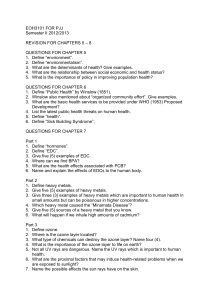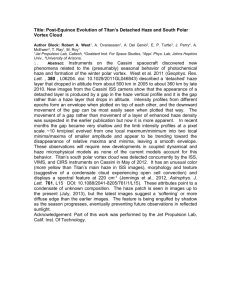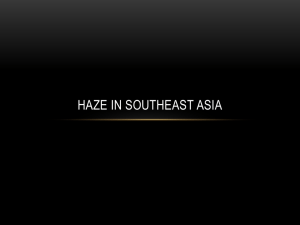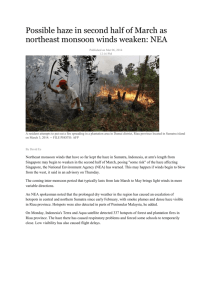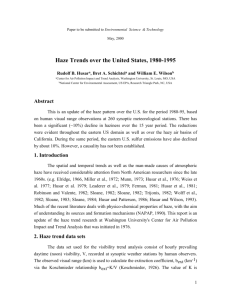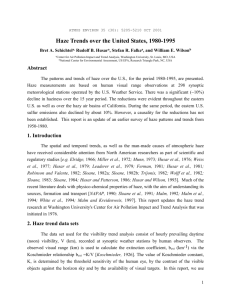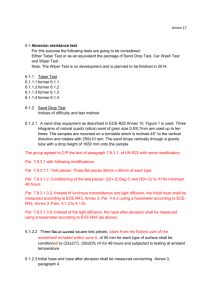Williams revisons
advertisement
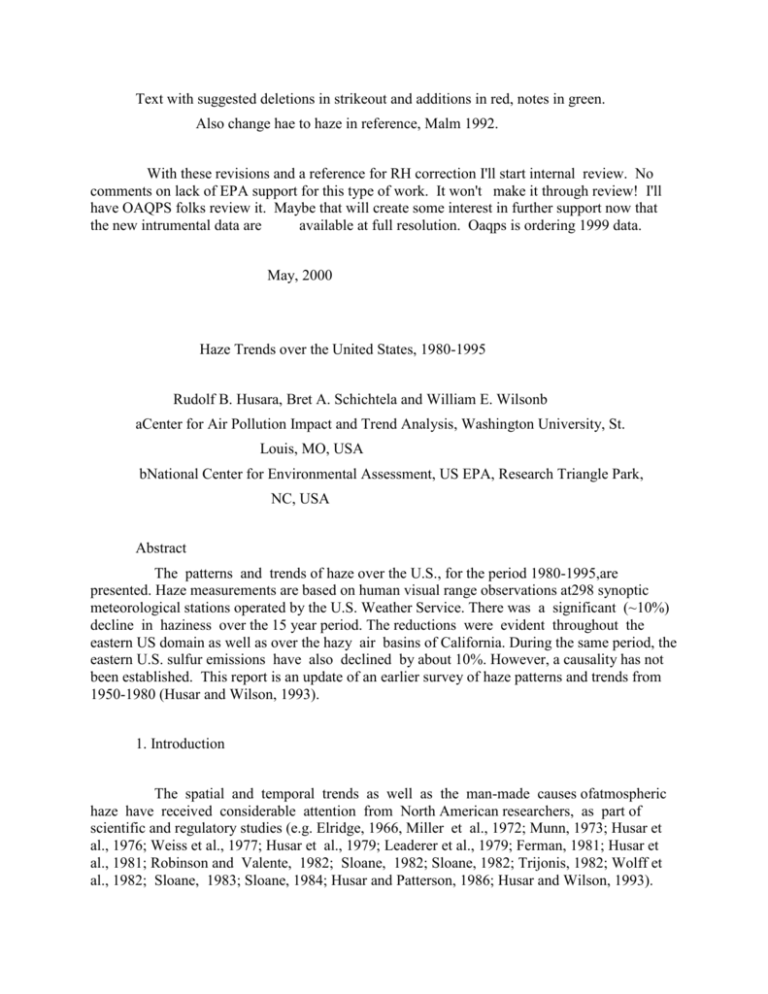
Text with suggested deletions in strikeout and additions in red, notes in green. Also change hae to haze in reference, Malm 1992. With these revisions and a reference for RH correction I'll start internal review. No comments on lack of EPA support for this type of work. It won't make it through review! I'll have OAQPS folks review it. Maybe that will create some interest in further support now that the new intrumental data are available at full resolution. Oaqps is ordering 1999 data. May, 2000 Haze Trends over the United States, 1980-1995 Rudolf B. Husara, Bret A. Schichtela and William E. Wilsonb aCenter for Air Pollution Impact and Trend Analysis, Washington University, St. Louis, MO, USA bNational Center for Environmental Assessment, US EPA, Research Triangle Park, NC, USA Abstract The patterns and trends of haze over the U.S., for the period 1980-1995,are presented. Haze measurements are based on human visual range observations at298 synoptic meteorological stations operated by the U.S. Weather Service. There was a significant (~10%) decline in haziness over the 15 year period. The reductions were evident throughout the eastern US domain as well as over the hazy air basins of California. During the same period, the eastern U.S. sulfur emissions have also declined by about 10%. However, a causality has not been established. This report is an update of an earlier survey of haze patterns and trends from 1950-1980 (Husar and Wilson, 1993). 1. Introduction The spatial and temporal trends as well as the man-made causes ofatmospheric haze have received considerable attention from North American researchers, as part of scientific and regulatory studies (e.g. Elridge, 1966, Miller et al., 1972; Munn, 1973; Husar et al., 1976; Weiss et al., 1977; Husar et al., 1979; Leaderer et al., 1979; Ferman, 1981; Husar et al., 1981; Robinson and Valente, 1982; Sloane, 1982; Sloane, 1982; Trijonis, 1982; Wolff et al., 1982; Sloane, 1983; Sloane, 1984; Husar and Patterson, 1986; Husar and Wilson, 1993). Much of the recent literature deals with physico-chemical properties of haze, with the aim of understanding its sources, formation and transport (strikethrough: and formation mechanisms, transport and relationship to sources )(NAPAP, 1990, Sloan et al., 1991, Malm, 1992, Malm et al., 1994, White et al., 1994, Malm and Kreidenweis, 1997). This report updates the haze trend research at Washington University's Center for Air Pollution Impact and Trend Analysis that was initiated in 1976. 2. Haze trend data sets The data set used for the visibility trend analysis consist of hourly prevailing daytime (noon) visibility, V (km), recorded at synoptic weather stations by human observers. The observed visual range (km) is used to calculate the extinction coefficient, b(subscript: ext )(km(superscript: -1)) via the Koschmieder relationship b(subscript: ext)=K/V (Koschmieder, 1926). The value of Koschmieder constant, K is determined by the threshold sensitivity of the human eye, by the contrast of the visible objects against the horizon sky, and by the availability of visual targets. In this report, we use K=1.9 in accordance with the data by Griffing (1980). The extinction coefficient is roughly proportional to the concentration of light scattering and absorbing aerosols and gases (NAPAP, 1990). The terms extinction coefficient and haze are used here synonymously. For purposes of spatial-temporal trend analysis, the raw visibility observations were summarized as quarterly aggregates of noontime light extinction coefficient(strikethrough: . The extinction coefficient) Visibility is influenced by both haze aerosol and natural obstructions to vision, such as rain, fog, and snow. The role of these natural obstructions (strikethrough: were) was eliminated by discarding the values (strikethrough: that occur when) caused by these meteorological phenomena (strikethrough: occur). The effect of relative humidity was compensated for by applying a RH correction factor to yield a "dry extinction coefficient". (Need a reference for the RH correction factor) Data were quality assured as described in Husar and Wilson (1993). (strikethrough: The specific parameter that is plotted for the haze maps is the 75th percentile of the seasonal bext distribution function. While this is unconventional, it is) The 75th percentile of the seasonal bext distribution function is the specific parameter chosen for use in the haze analysis. While unconventional this constitutes the safest approach in that it does not require any extrapolation or other adjustments to the data. A significant problem with airport visual range observations is that there is a furthest marker beyond which the visual range is not resolved (Husar and Wilson, 1993). More conventional statistical measures, e.g. the mean can be estimated as follows: from previous research, e.g. Husar et al., (1979), the extinction coefficient is roughly lognormal with a typical logarithmic standard deviation of 2.5. For such a distribution, the 50th percentile is 0.5 times the 75th percentile, and the mean is 0.76 times the 75th percentile. The spatial patterns are presented on contour maps. The contours were derived from the station-point observations using a spatial extrapolation scheme, described previously (Husar et al., 1994) 3. National seasonal trend maps The U.S. haze patterns and trends since 1980 are shown in 12 seasonal maps covering 5-year periods, centered at 1983, 1988, and 1993. (Figure 1). The seasons are defined by calendar quarter (i.e., summer is June, July and August). The overall national view shows two large contiguous haze regions, one over the eastern U.S. and the other along the Pacific coast. In between the two haze regions lies a low-haze (strikethrough: free) territory that spans from the Rocky Mountains to the Sierra-Cascade mountain ranges. This general pattern was preserved over the past 30-year period (Husar and Wilson, 1993). However, notable trends have occurred over both the western and the eastern haze regions. The maps in Figure 1 (1980-1995) show that over the eastern U.S., the dry extinction coefficient is highest during the summer season (Quarter 3). The highest extinction coefficient (bext>0.2 km-1 , equivalent to a visibility distance of 6 miles) is observed adjacent to the Appalachian Mountains in Tennessee and the Carolinas. In comparison on the periphery of the eastern U.S. (Maine, Florida, Texas, North Dakota) the summer-time extinction coefficient is less than half (bext<0.1 km-1) of the values near the center of the eastern U.S. The dry extinction coefficient (Figure 1) over the eastern U.S. during the cold season, Quarters 1 and 4, depict elevated haze values (bext>0.2 km-1) between the Great Lakes and the Ohio River Valley. Another region of cold-season haze is found over the Gulf states between Texas and Florida, and along the mid-Atlantic coast from North Carolina to New Jersey. The summertime (strikethrough: (June, July, August)) bext trends over the eastern U.S. for the fifteen year period 1980-95 are presented in Figure 2. The trends were computed for the 75th and 90th percentile using data from all stations east of the Mississippi River (eastern U.S.), north of Virginia and east of Ohio (northeastern U.S.) and south of Tennessee and east of Mississippi (southeastern U.S.). As shown, over the eastern U.S. there was a 17% decrease in the 90th percentile bext over the fifteen year period, and a 9% decrease of the 75th percentile. Larger decreases in bext were observed in the southeastern U.S., where the 90th and 75th percentiles decreased by 20% and 12 % respectively. The decreases over the Northeast for the 90th and 75th percentiles where 16% and 8% respectively. As a result of these declines, the extinction coefficient was below 0.2 km-1 by 1991-95, throughout most of the eastern U.S., as shown in the right columns in Figure 1. The haze pattern and trends over the visually pristine inter-mountain western U.S. can not be evaluated due to the poor distance resolution of the visual range database. Very few monitoring sites report visibility above 30-50 km (0.038<bext<0.063). Elevated haze (bext>0.1 km-1) can be observed throughout the Pacific coast of the U.S., particularly in central and southern California (San Joaquin and the Los Angeles basins). The haze is worst during the cold season (Quarters 4 and 1) when bext exceeds 0.2 km-1. During the period 1981-1995, the level of haze has significantly (10%) declined throughout the Pacific coast, including the San Joaquin and Los Angeles basins. Since sulfate constitutes 40-70% (NAPAP, 1990) of the light scattering aerosol over the eastern US, the trend of bext is compared to the sulfur emission trends in Figure 3. The emission data prior to 1985 were taken from Knudson (1985) and Husar (1986) while the values after 1985 were from the National Emissions Trend (NET) emission inventory (US EPA, 1998). The National Acid Precipitation Assessment Program and US EPA report regularly on progress and trends in the effects of SO2 and NOx emissions, including the effects on visibility (NAPAP, 1998; EPA, 1999). An unusual feature of the sulfur emissions data is the sharp drop in 1995. The comparison in Figure 3, indicates that both the eastern U.S. average bext and sulfur emissions have declined by about 10% during the 15-year period. Declines are also evident for the Northeastern and the Southeastern U.S. However, the relationship varies significantly from year to year. 4. Discussion This haze trend update indicates that, during the 1980-1995 period, (strikethrough: the haziness has ) haziness declined significantly (~10%) throughout the country. The frequency of eastern U.S. haze episodes (90th percentile of bext) has declined even faster (17%). Since the visibility-derived haziness is a surrogate for PM2.5 concentration, these results imply that there was also a substantial (~10%) decline in the national PM2.5 levels as well. The causes of the haze and PM2.5 decline were not investigated here in detail. However, it is noted that the haze decline coincided with reductions in the sulfur emissions in the eastern US. In order to establish fully the causality of the observed reductions, additional work needs to be focused on the trends of specific aerosol chemical species, possible changes in the oxidation capacity of the atmosphere, and trends of relevant meteorological variables. This work further supports the notion that the haze trend data provide a way to monitor the effectiveness of the emission reductions from the 1990 Clean Air Act Amendment. Previous work (Husar and Wilson, 1993) has also linked the regional and seasonal shifts in eastern U.S. haziness to haze precursor emission patterns. Since the late 1980s, visibility trend maps, similar to the ones presented here, were used in the National Air Quality and Emissions Trends report issued by EPA. The Trend Report is the official yearly report card on the nations air quality. It is regrettable that this may be the last U.S. haze trend update based on the surface visibility observations. Beginning in the early 1990's, an increasing number of sites have begun collecting visibility data with automatic light scattering sensors that are not fully compatible with the 50-year long uman observations. (strikethrough: In addition, the U.S EPA Trends Reports no longer report this type of visibility trend analyses. )(strikethrough: [Secondly, the U.S. EPA has discontinued support for this type of visibility trend analyses])(strikethrough: )
